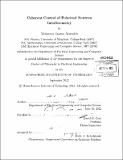| dc.contributor.advisor | David G. Cory. | en_US |
| dc.contributor.author | Abutaleb, Mohamed Osama | en_US |
| dc.contributor.other | Massachusetts Institute of Technology. Department of Electrical Engineering and Computer Science. | en_US |
| dc.date.accessioned | 2013-04-12T19:24:13Z | |
| dc.date.available | 2013-04-12T19:24:13Z | |
| dc.date.copyright | 2012 | en_US |
| dc.date.issued | 2012 | en_US |
| dc.identifier.uri | http://hdl.handle.net/1721.1/78441 | |
| dc.description | Thesis (Ph. D.)--Massachusetts Institute of Technology, Dept. of Electrical Engineering and Computer Science, 2012. | en_US |
| dc.description | Cataloged from PDF version of thesis. | en_US |
| dc.description | Includes bibliographical references (p. 171-179). | en_US |
| dc.description.abstract | In this thesis, we describe two sets of experiments using a single crystal neutron interferometer. First, we explore applications of quantum information processing (QIP) to magnetic materials characterization using polarized neutron interferometry (NI). We describe a split path spin-based interferometer geometry that uses the Bragg interferometer to separate two paths where spin states are independently manipulated. The final measurement is made on the spin degree of freedom, so we observe spin-based contrast without a need for coherence in the path degree of freedom. This is difficult to achieve in a spin-echo interferometer because the two paths overlap, with only a time delay of one relative to the other. Second, we present a design of a novel spin rotator design meeting the stringent space and temperature constraints of NI experiments. These passive devices use remnant magnetization FeCoV thin films and can be tuned to achieve arbitrary rotation of an incident neutron with known magnetization. Polarized neutron reflectometry measurements are reported for FeCoV monolayer films at thicknesses of 0.5 [mu]m and 5.3 [mu]m to characterize the depth-dependent vector magnetization in the films. Stray field near such films is characterized to determine the effect on the neighboring neutron beam path. Contrast degradation due to the rotators is also discussed. Results for a prototype set of film rotators are presented showing a spin nutation > 90° from incident orientation. An architecture is presented for which any nutation angle can be achieved by tuning the separation of two composite film structures. We also propose an experimental implementation of the deterministic quantum computation with one pure qubit (DQC1) model of quantum computation in NI. This circuit generates no entanglement, yet no efficient classical simulation is known or thought to exist. We present calculations showing a nonzero quantum discord in this implementation, as a means of quantifying other nonclassical correlations in addition to entanglement. All experiments were conducted at the Neutron Interferometer and Optics Facility at the National Institute of Standards and Technology (NIST). | en_US |
| dc.description.statementofresponsibility | by Mohamed Osama Abutaleb. | en_US |
| dc.format.extent | 179 p. | en_US |
| dc.language.iso | eng | en_US |
| dc.publisher | Massachusetts Institute of Technology | en_US |
| dc.rights | M.I.T. theses are protected by
copyright. They may be viewed from this source for any purpose, but
reproduction or distribution in any format is prohibited without written
permission. See provided URL for inquiries about permission. | en_US |
| dc.rights.uri | http://dspace.mit.edu/handle/1721.1/7582 | en_US |
| dc.subject | Electrical Engineering and Computer Science. | en_US |
| dc.title | Coherent control of polarized neutron interferometry | en_US |
| dc.type | Thesis | en_US |
| dc.description.degree | Ph.D. | en_US |
| dc.contributor.department | Massachusetts Institute of Technology. Department of Electrical Engineering and Computer Science | |
| dc.identifier.oclc | 831414807 | en_US |
